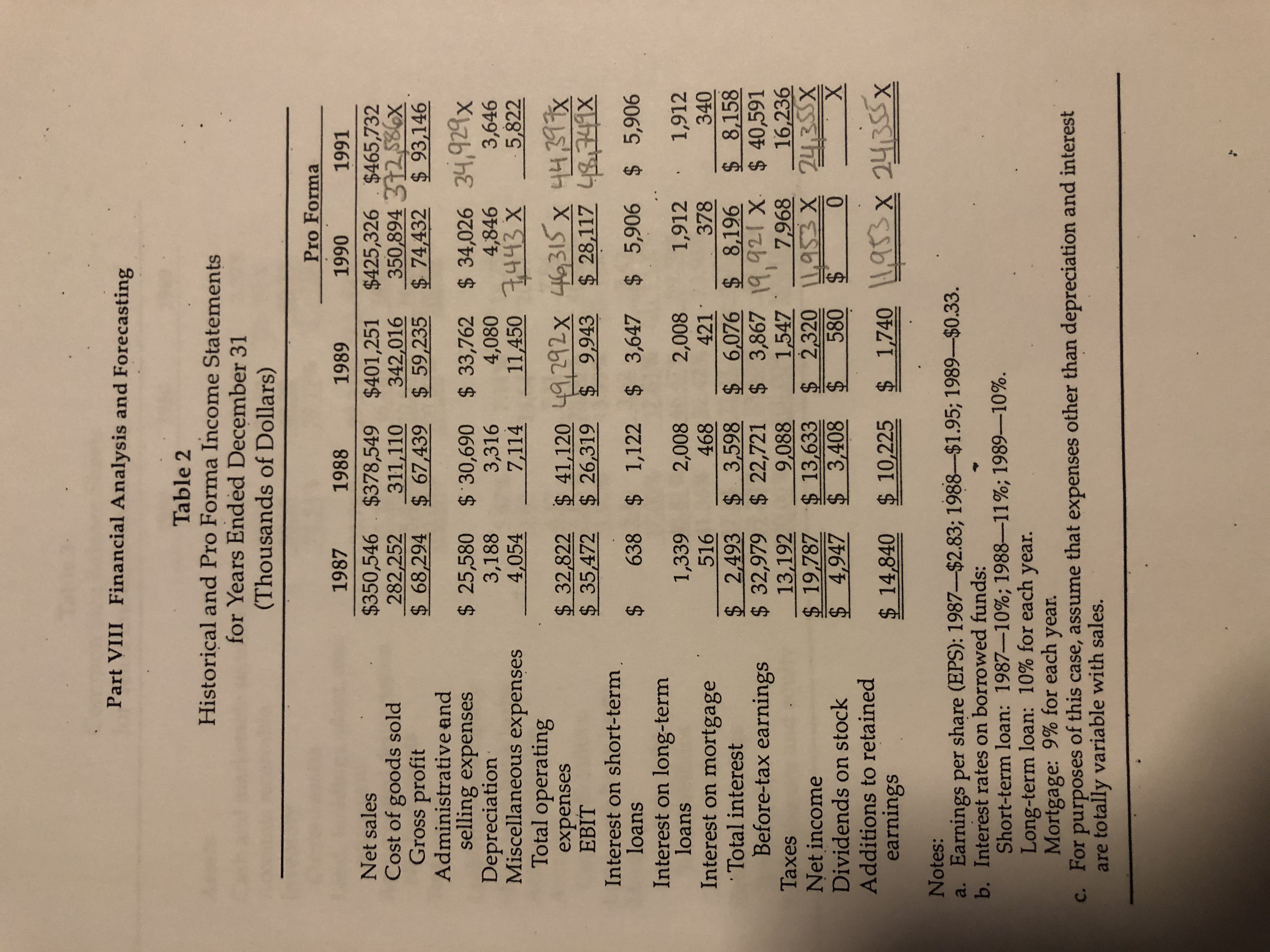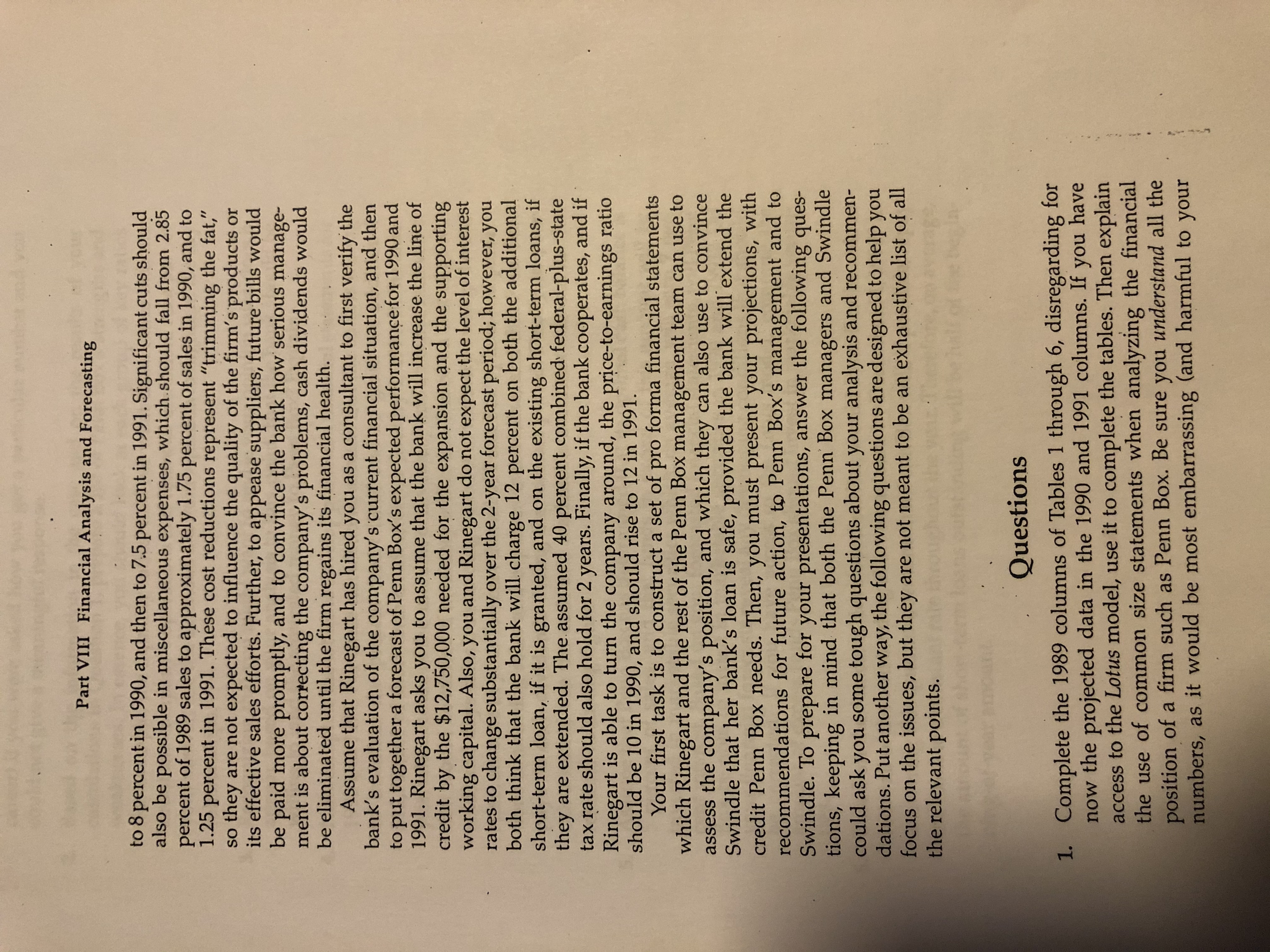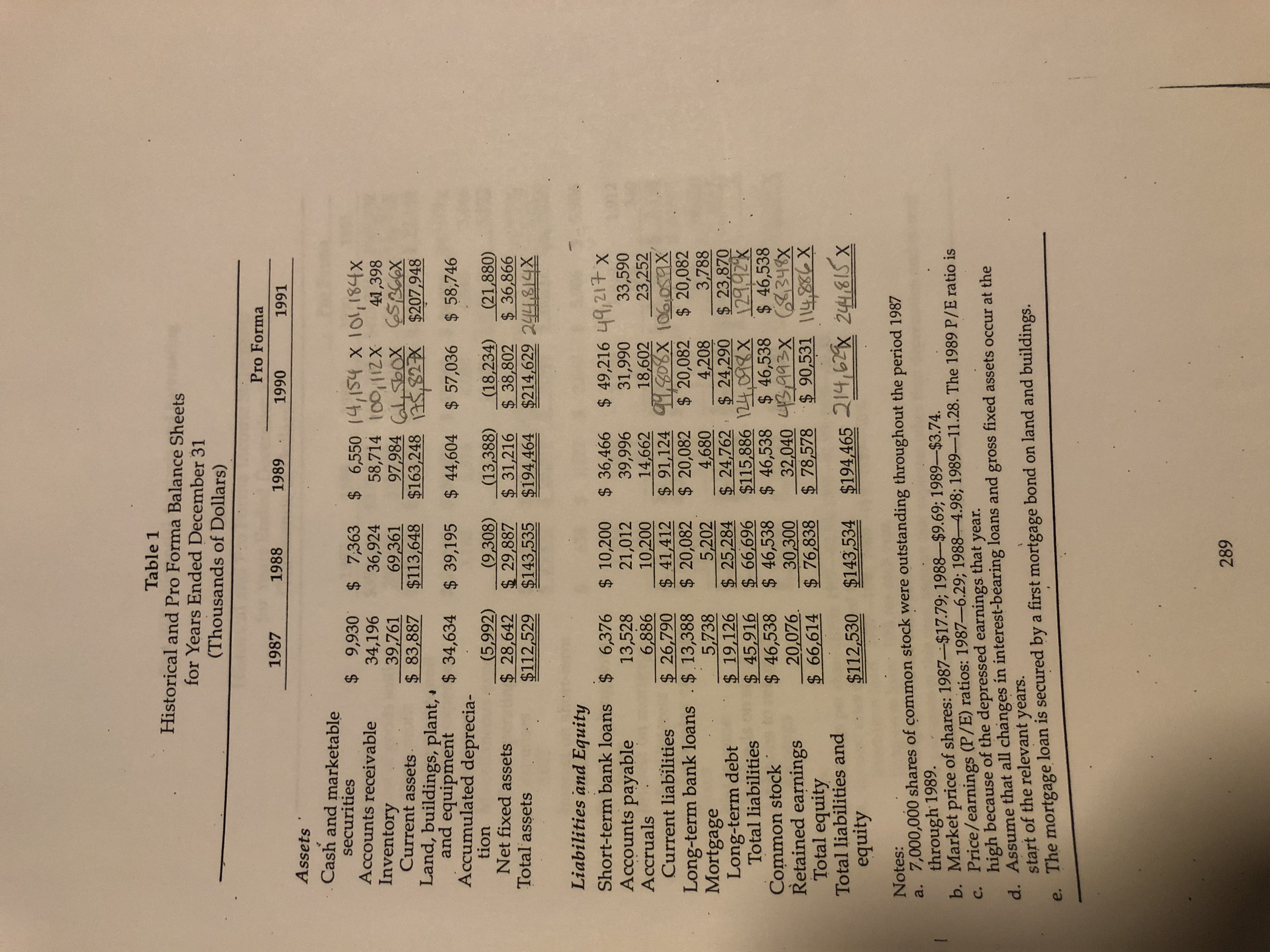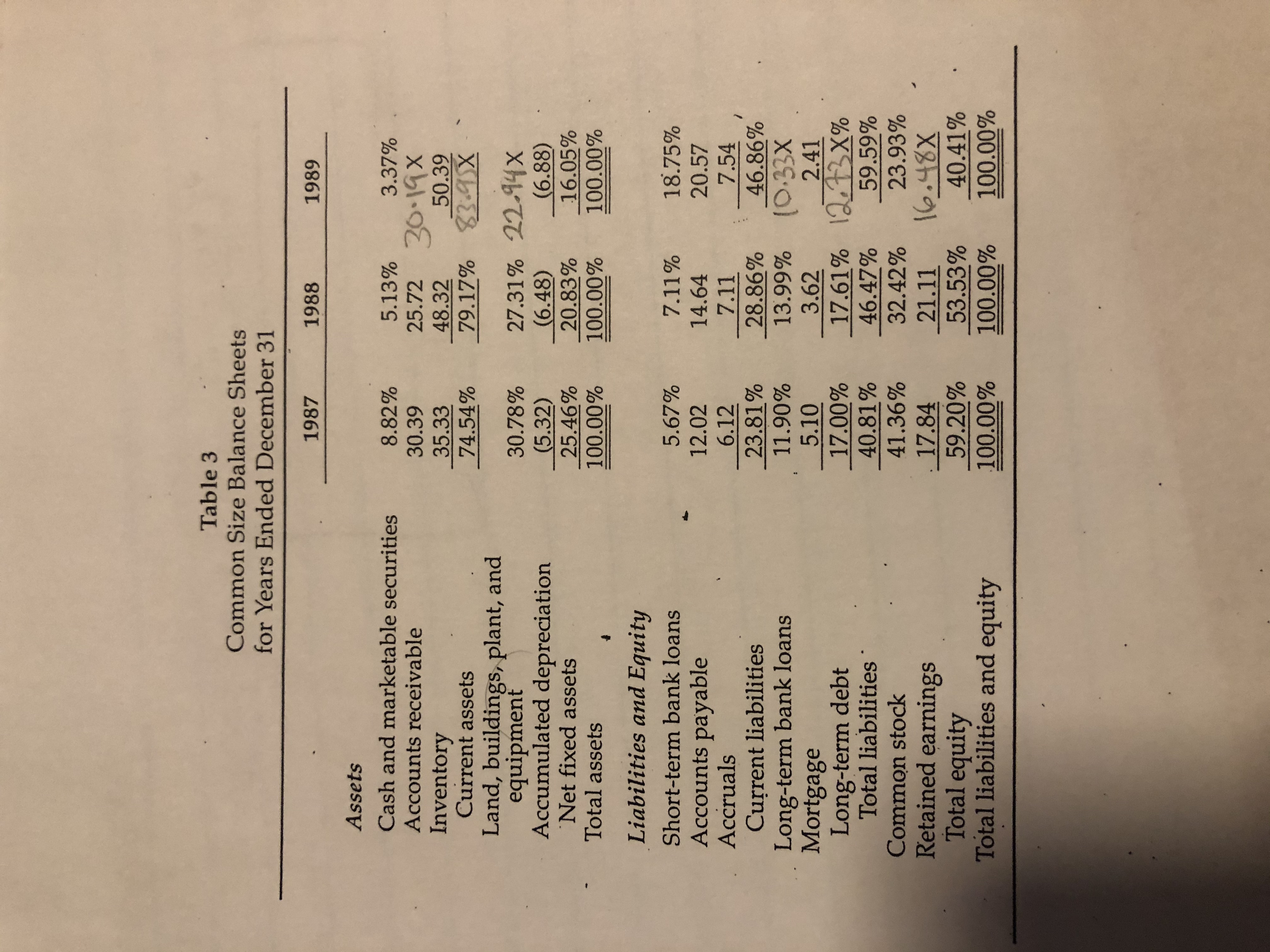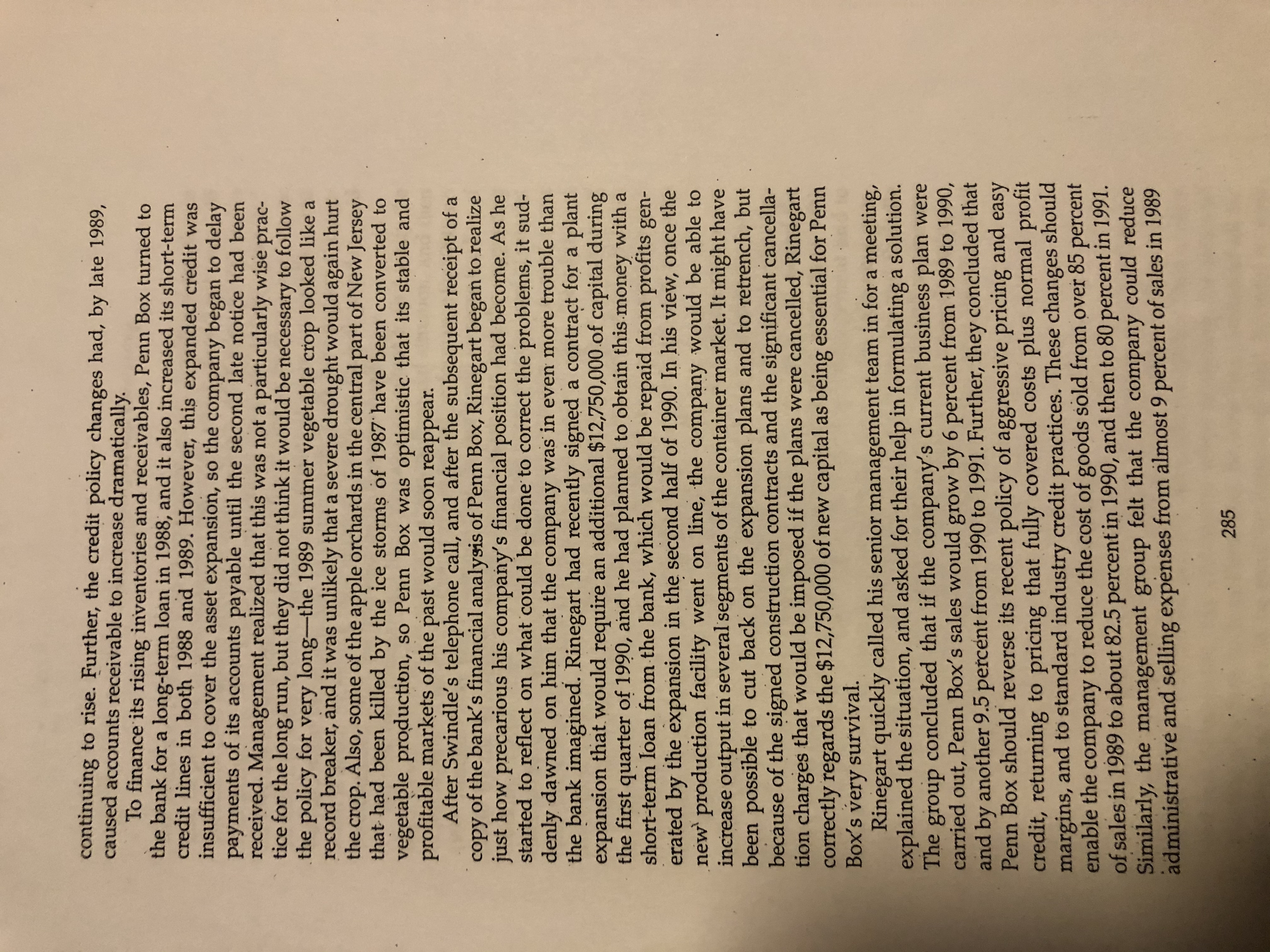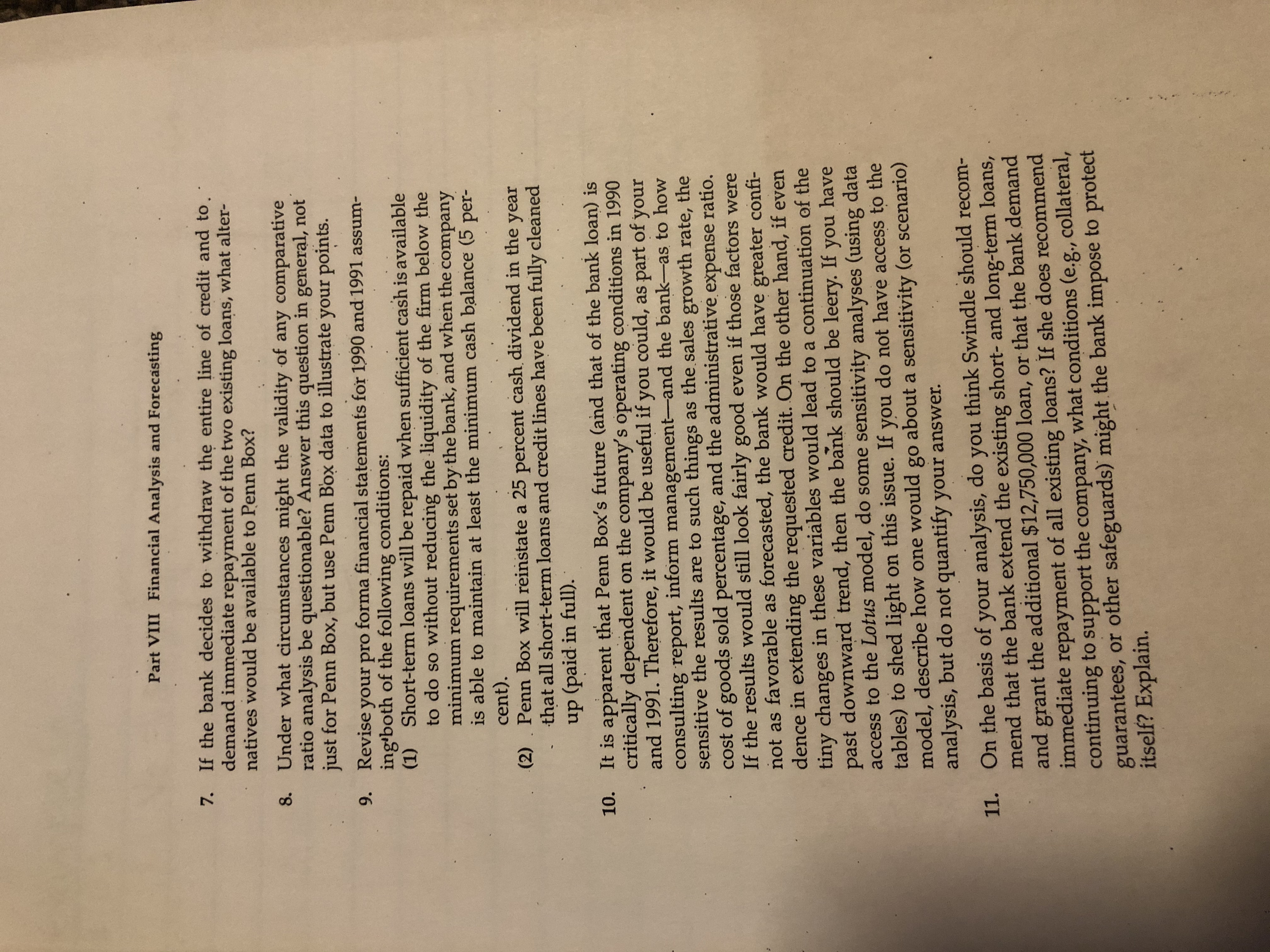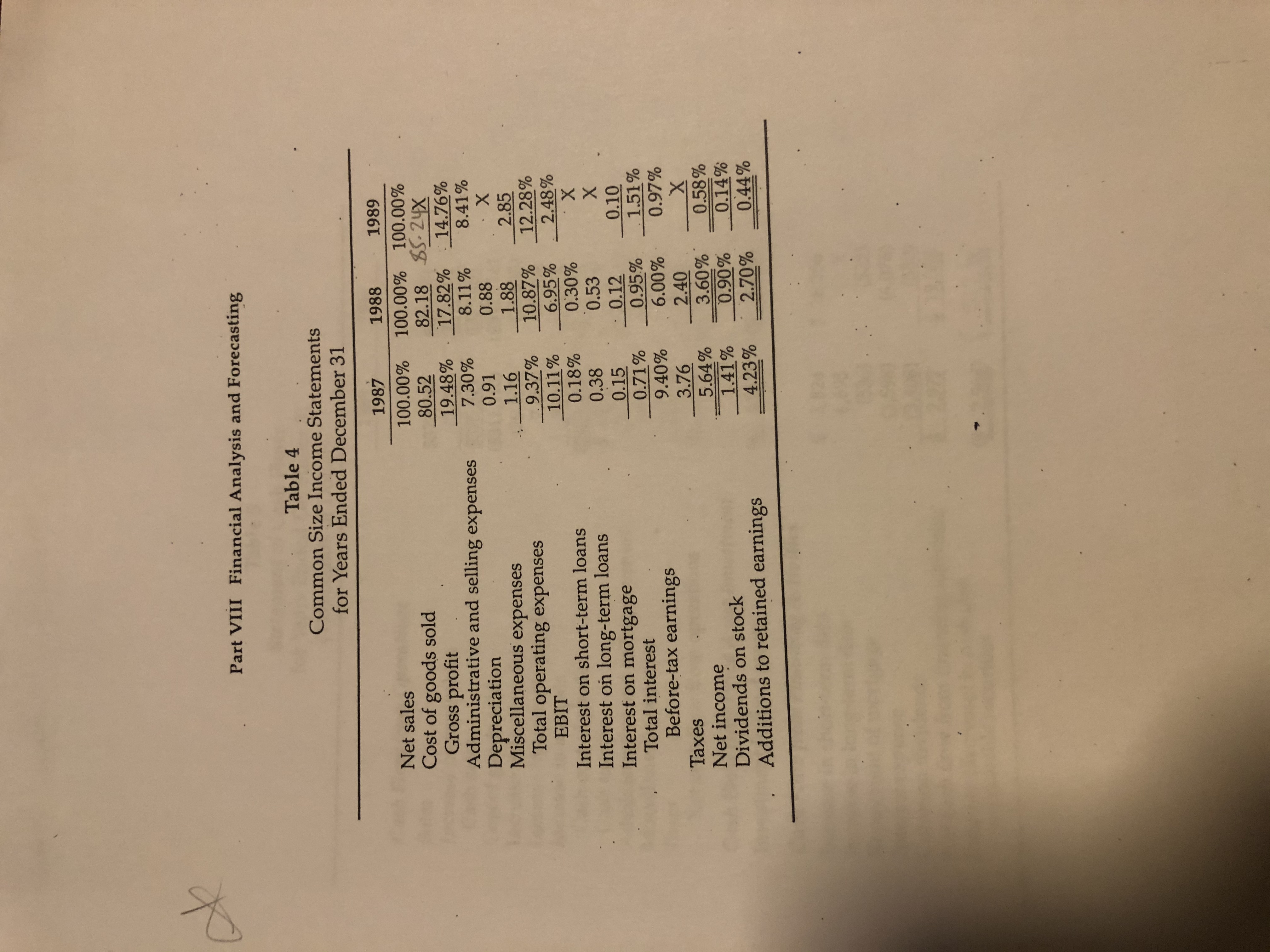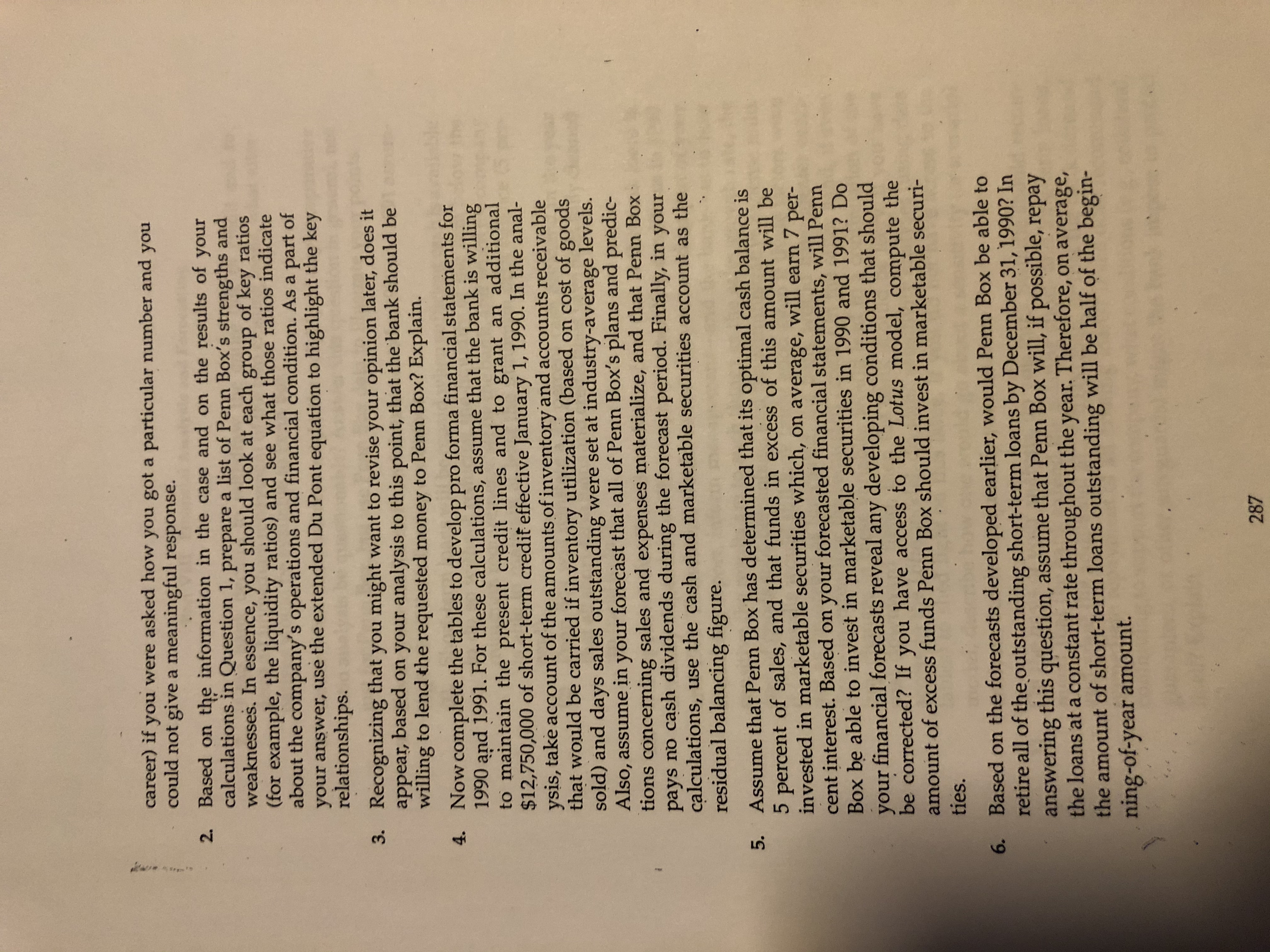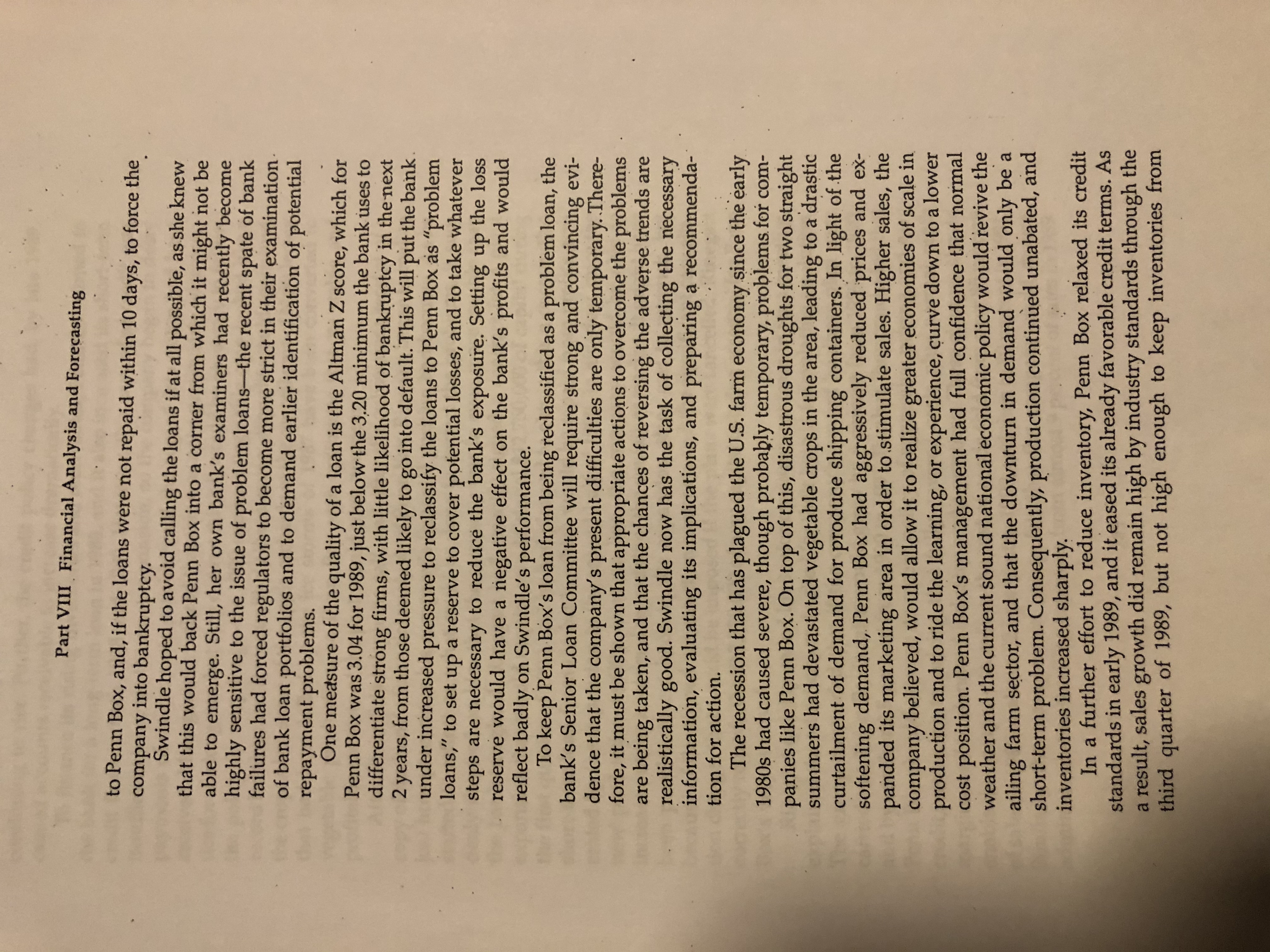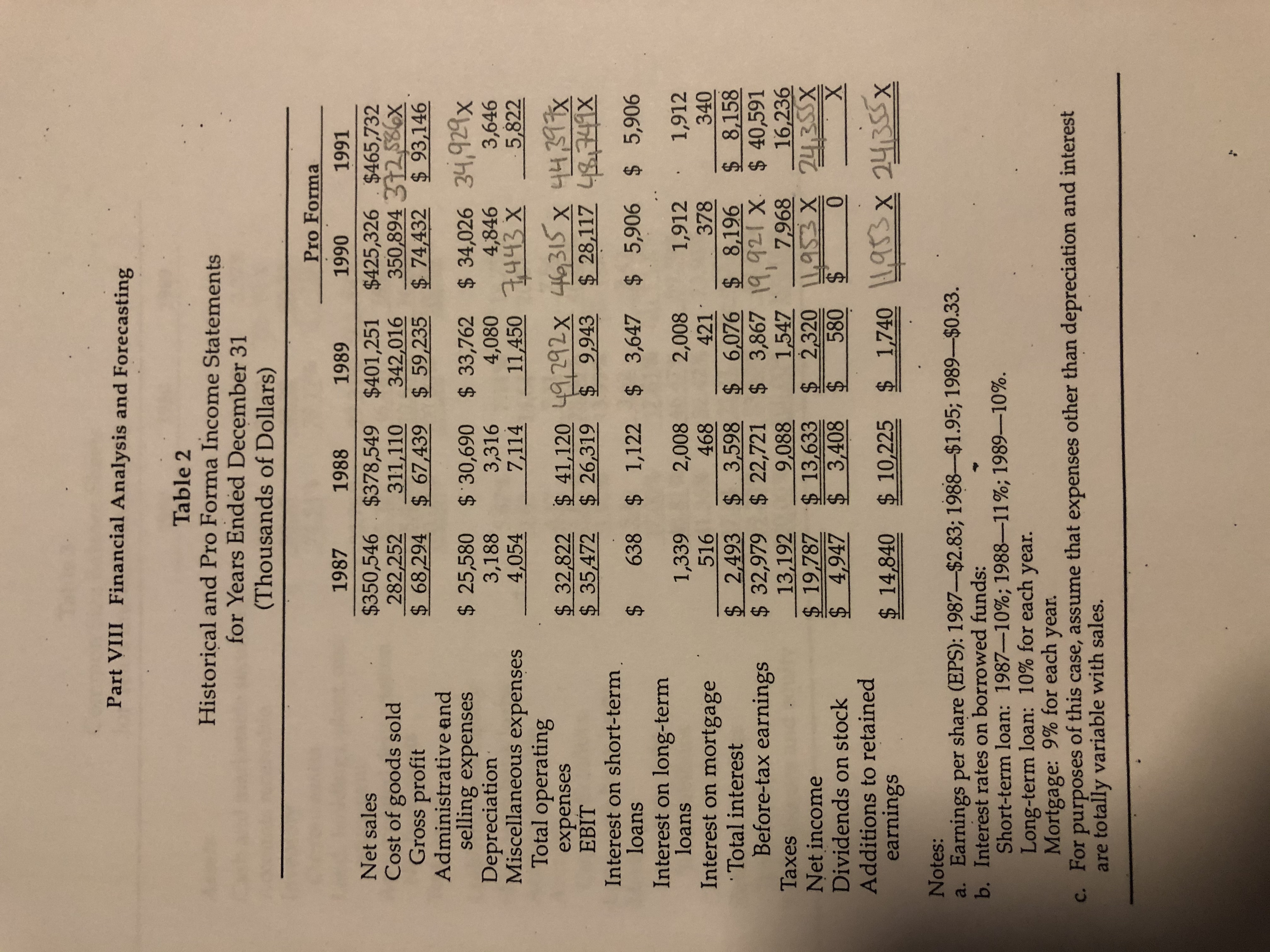
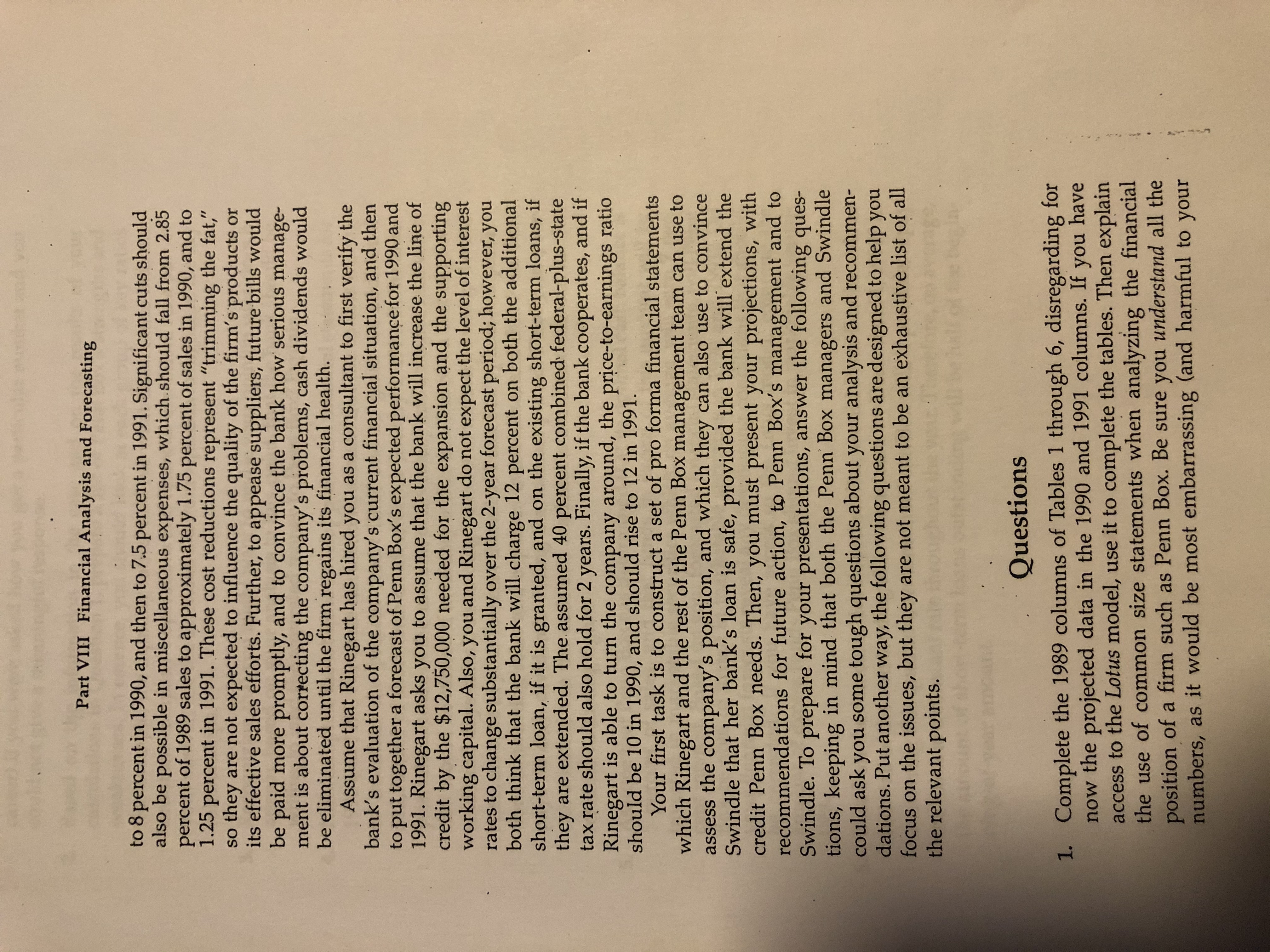
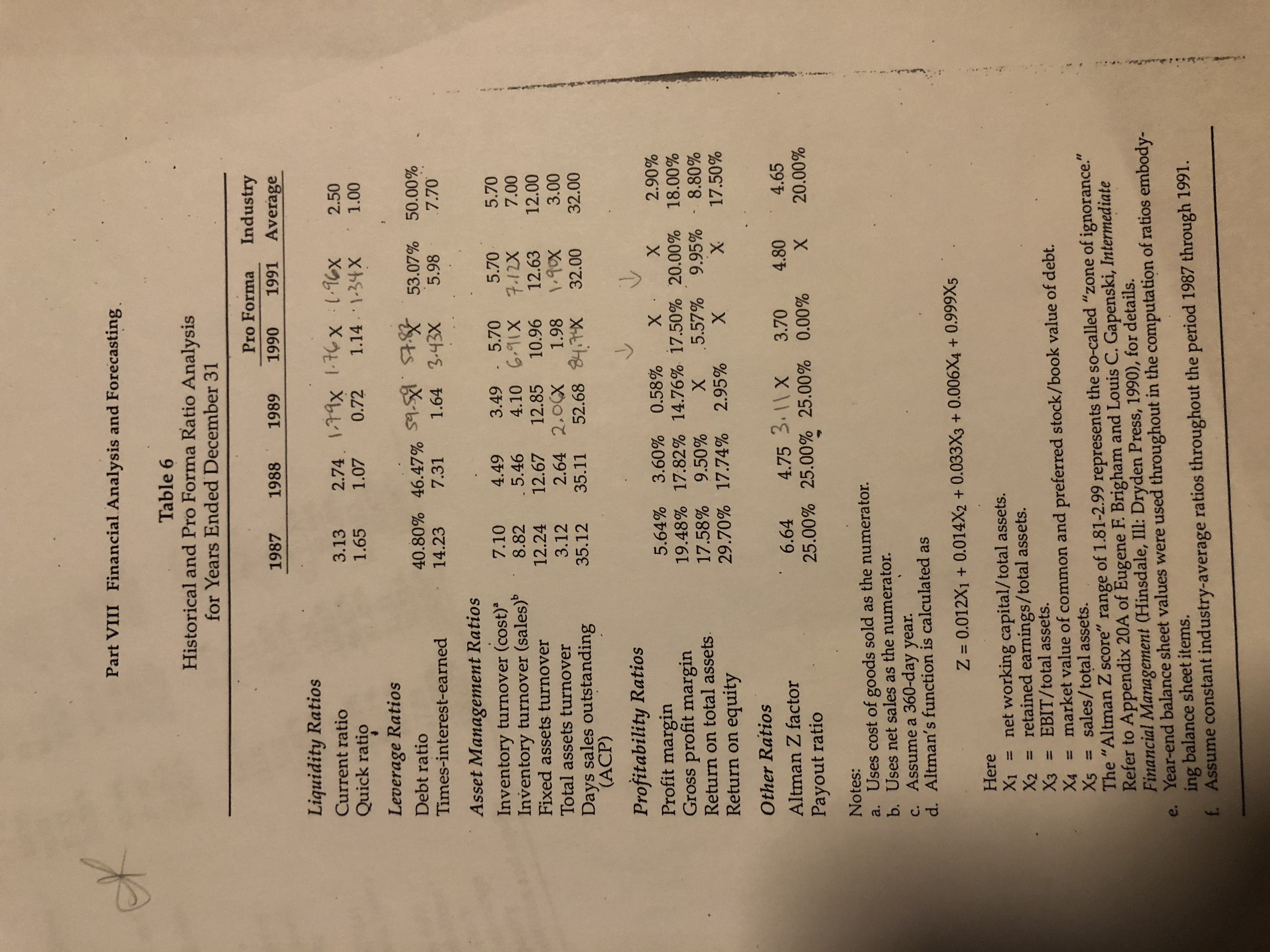
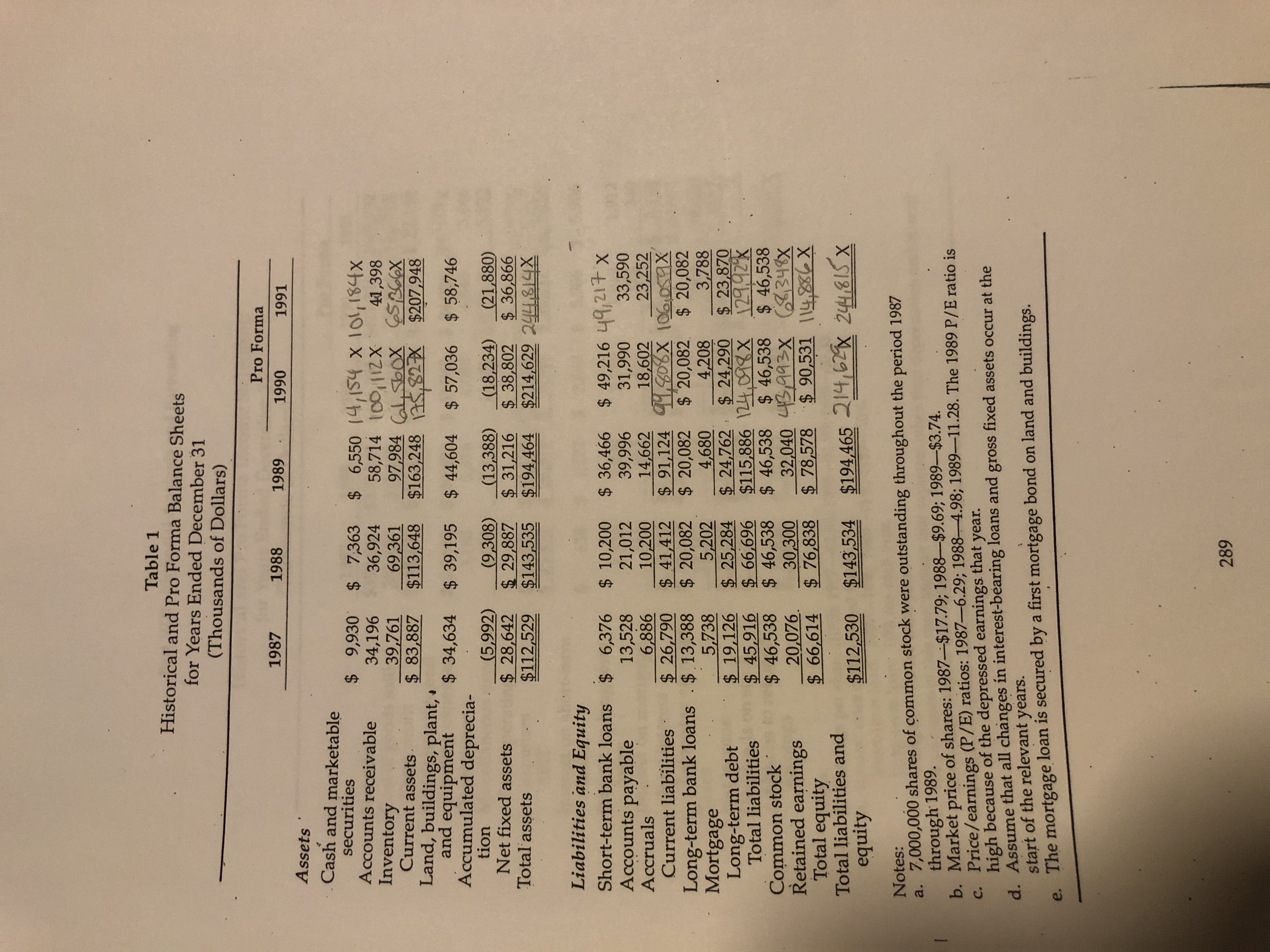
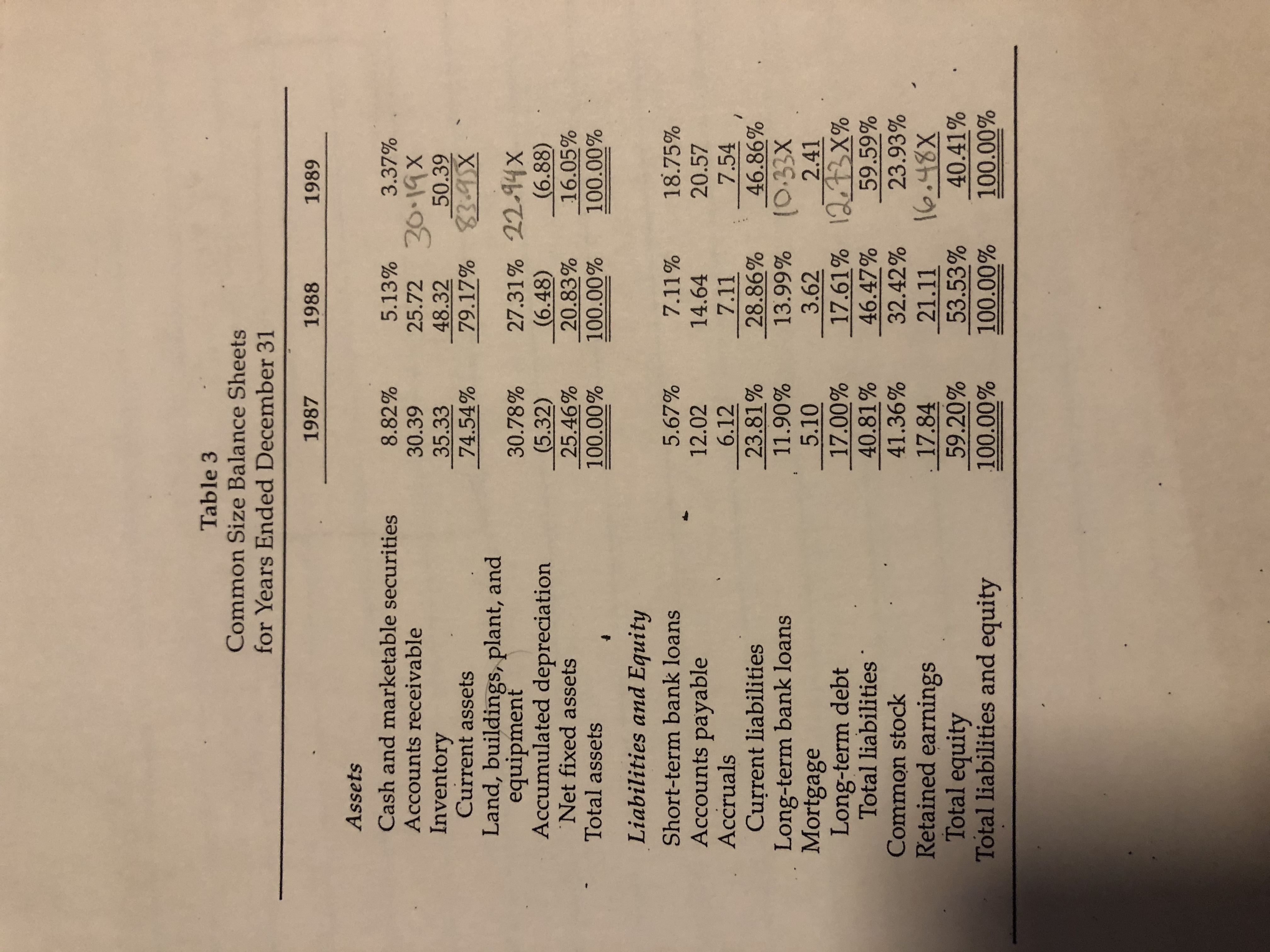

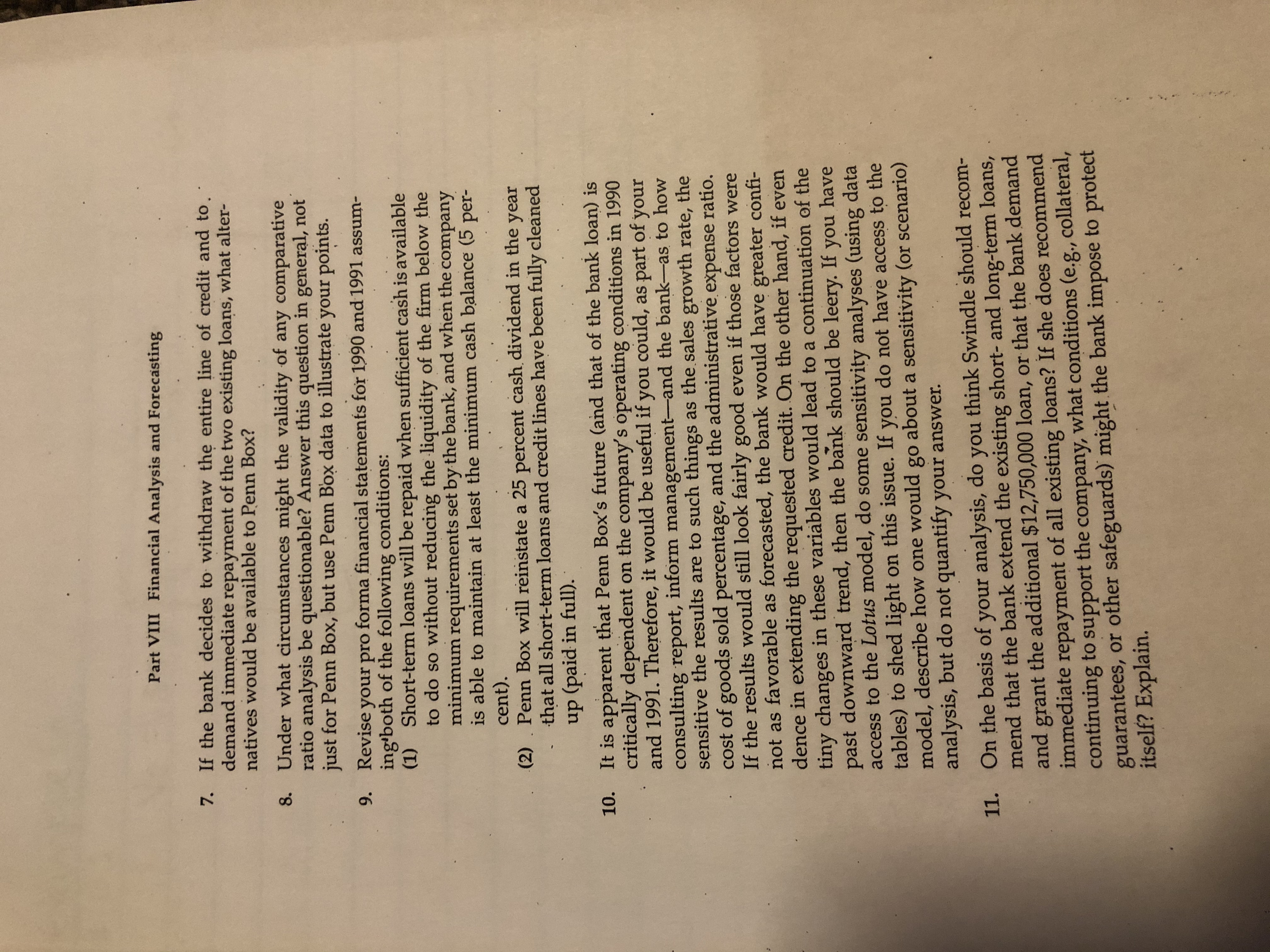
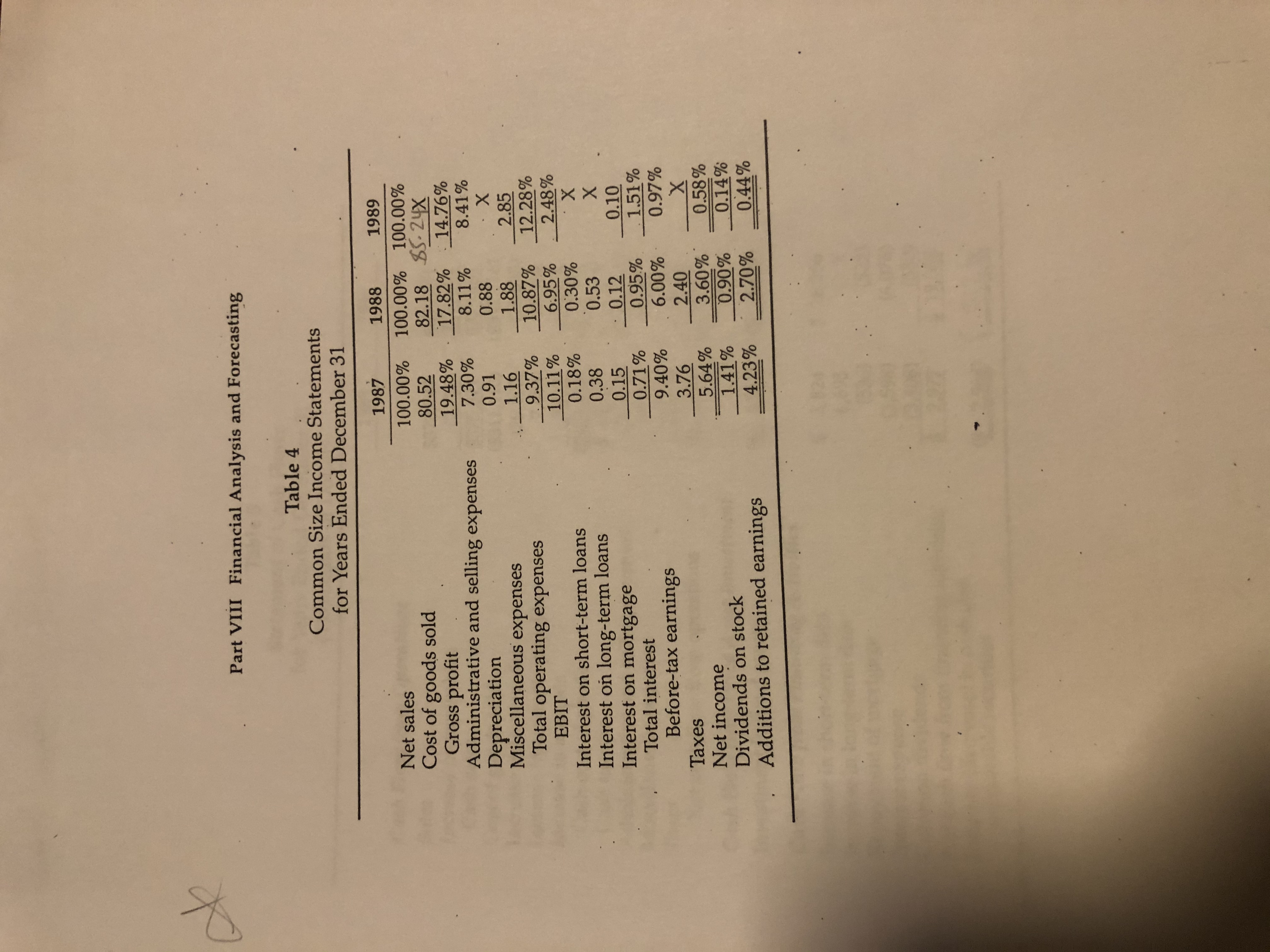
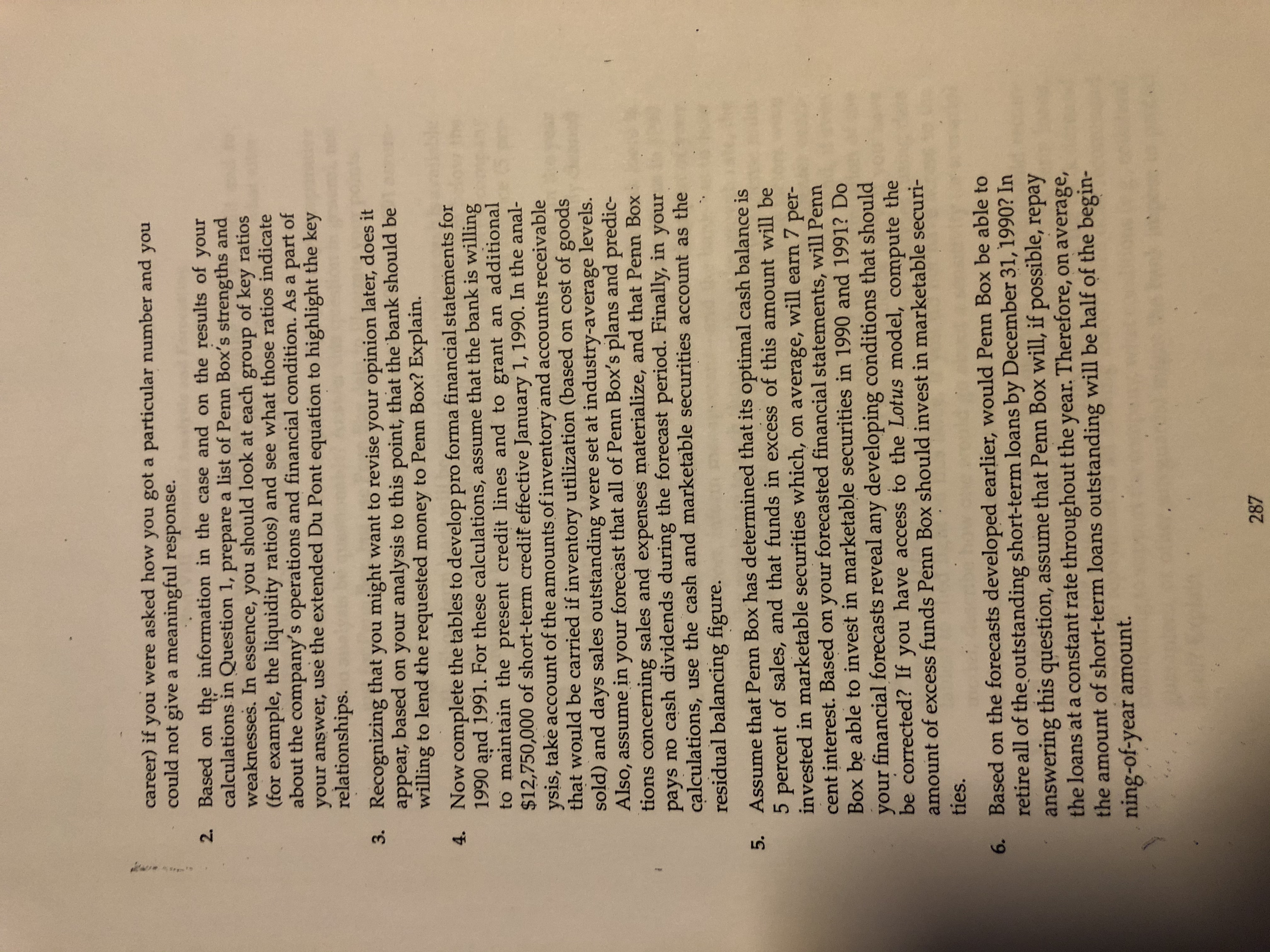
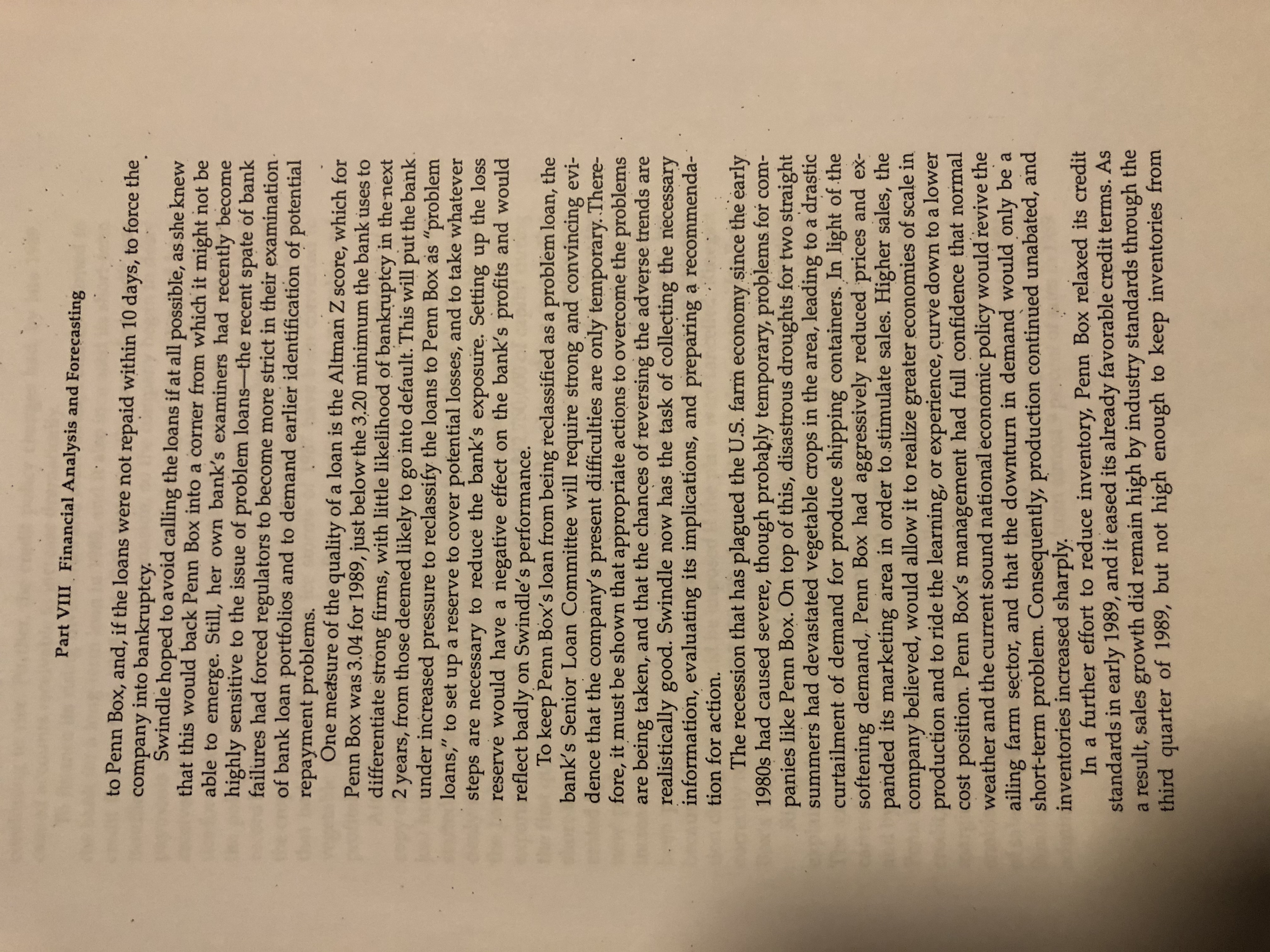
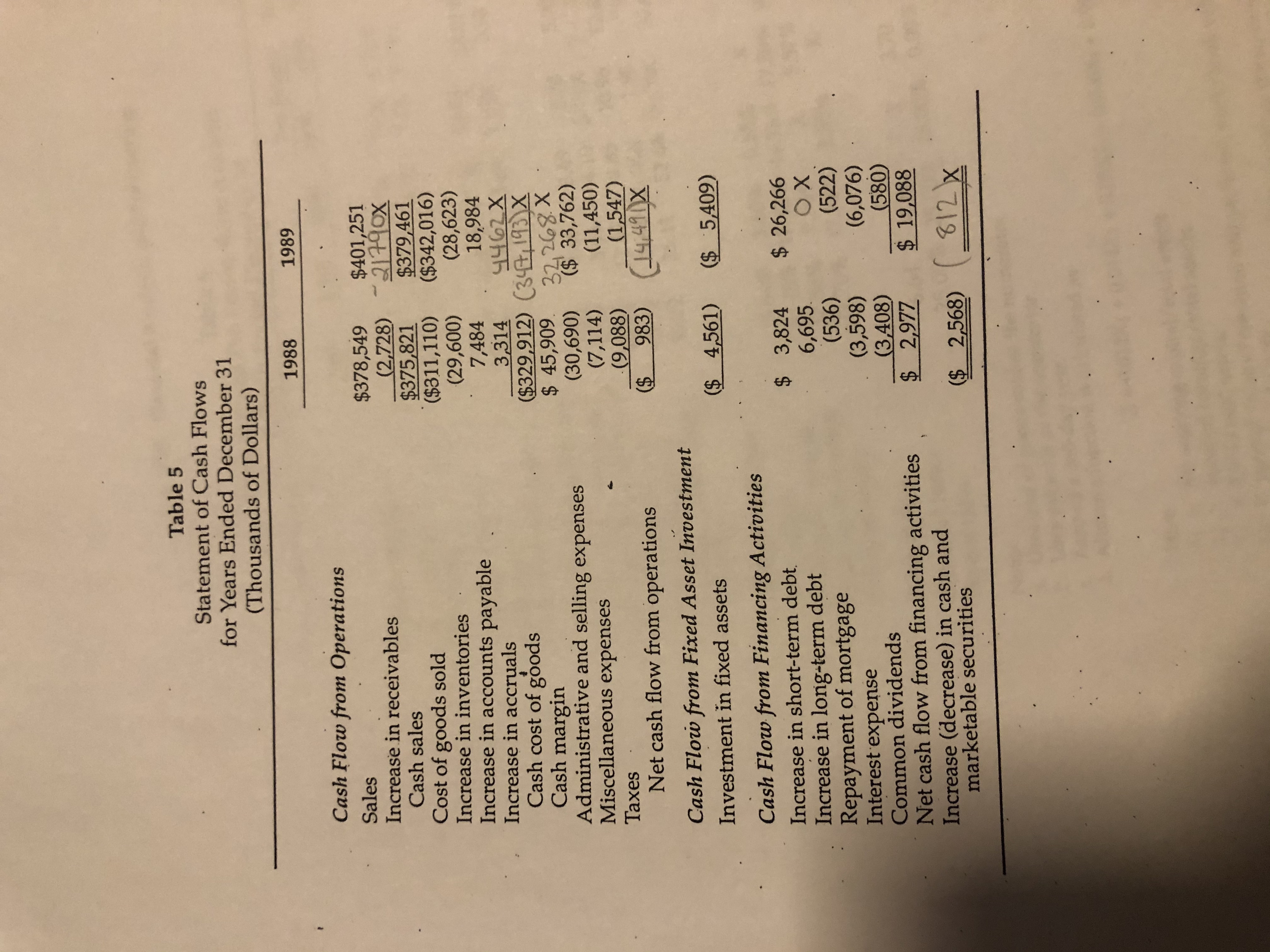
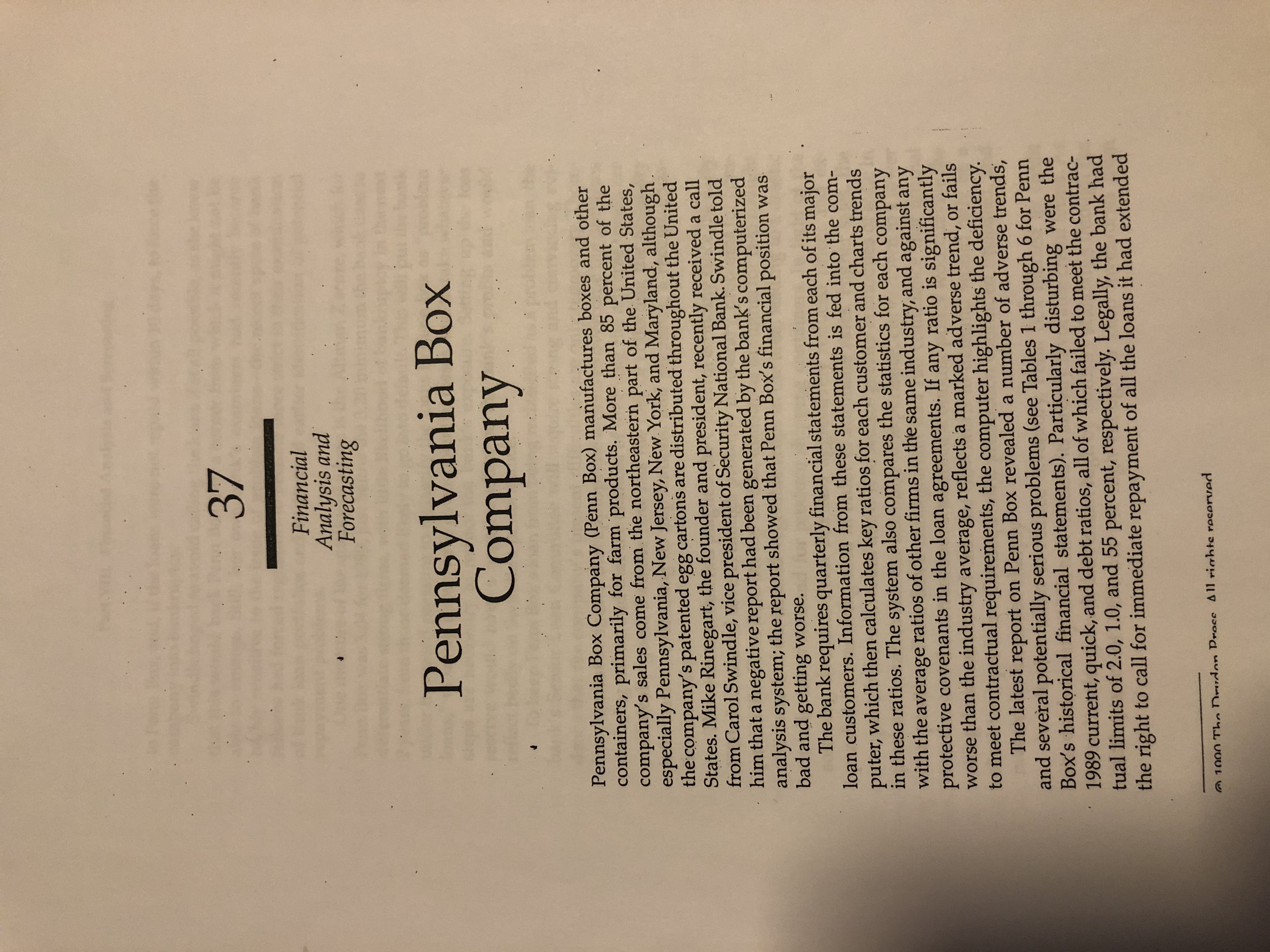
I need homework help with Financial Analysis & Forecasting for a case. Pennsylvania Box Company. So far, I was able to complete Tables 1-3. I need assistance with the rest, table 4-6 and the analysis questions 1-12. How to explain the meaning behind these numbers? pictures will be attached below.
Part VIII Financial Analysis and Forecasting Table 2 Historical and Pro Forma Income Statements for Years Ended December 31 (Thousands of Dollars) Pro Forma 1987 1988 1989 1990 1991 Net sales $350,546 $378,549 $401,251 $425,326 . $465,732 Cost of goods sold 282,252 311,110 342,016 350,894 312 586X Gross profit $ 68,294 $ 67,439 $ 59,235 $ 74,432 $ 93,146 Administrative and selling expenses $ 25,580 $ 30,690 $ 33,762 $ 34,026 34,929x Depreciation 3,188 3,316 4,080 4,846 3,646 Miscellaneous expenses 4,054 7,114 11,450 7443 X 5,822 Total operating expenses $ 32,822 $ 41,120 49,292x 46,315 x 44,397x EBIT $ 35,472 $ 26,319 $ 9,943 $ 28,117 48 349X Interest on short-term loans $ 638 $ 1,122 $ 3,647 $ 5,906 $ 5,906 Interest on long-term loans 1,339 2,008 2,008 1,912 1,912 Interest on mortgage 516 468 421 378 340 Total interest $ 2,493 $ 3,598 $ 6,076 $ 8,196 $ 8,158 Before-tax earnings $ 32,979 $ 22,721 $ 3,867 19, 921 X $ 40,591 Taxes 13,192 9,088 1,547 7,968 16,236 Net income $ 19,787 $ 13,633 $ 2,320 11 953 X 24, 35SX Dividends on stock $ 4,947 $ 3,408 580 $ 0 X Additions to retained earnings $ 14,840 $ 10,225 $ 1,740 1,953 X 24 35 X Notes: a. Earnings per share (EPS): 1987-$2.83; 1988-$1.95; 1989-$0.33. b. Interest rates on borrowed funds: Short-term loan: 1987-10%; 1988-11%; 1989-10%. Long-term loan: 10% for each year. Mortgage: 9% for each year. c. For purposes of this case, assume that expenses other than depreciation and interest are totally variable with sales.Part VIII Financial Analysis and Forecasting to 8 percent in 1990, and then to 7.5 percent in 1991. Significant cuts should also be possible in miscellaneous expenses, which should fall from 2.85 percent of 1989 sales to approximately 1.75 percent of sales in 1990, and to 1.25 percent in 1991. These cost reductions represent "trimming the fat," so they are not expected to influence the quality of the firm's products or its effective sales efforts. Further, to appease suppliers, future bills would be paid more promptly, and to convince the bank how serious manage- ment is about correcting the company's problems, cash dividends would be eliminated until the firm regains its financial health. Assume that Rinegart has hired you as a consultant to first verify the bank's evaluation of the company's current financial situation, and then to put together a forecast of Penn Box's expected performance for 1990 and 1991. Rinegart asks you to assume that the bank will increase the line of credit by the $12,750,000 needed for the expansion and the supporting working capital. Also, you and Rinegart do not expect the level of interest rates to change substantially over the 2-year forecast period; however, you both think that the bank will charge 12 percent on both the additional short-term loan, if it is granted, and on the existing short-term loans, if they are extended. The assumed 40 percent combined federal-plus-state tax rate should also hold for 2 years. Finally, if the bank cooperates, and if Rinegart is able to turn the company around, the price-to-earnings ratio should be 10 in 1990, and should rise to 12 in 1991. Your first task is to construct a set of pro forma financial statements which Rinegart and the rest of the Penn Box management team can use to assess the company's position, and which they can also use to convince Swindle that her bank's loan is safe, provided the bank will extend the credit Penn Box needs. Then, you must present your projections, with recommendations for future action, to Penn Box's management and to Swindle. To prepare for your presentations, answer the following ques- tions, keeping in mind that both the Penn Box managers and Swindle could ask you some tough questions about your analysis and recommen dations. Put another way, the following questions are designed to help you focus on the issues, but they are not meant to be an exhaustive list of all the relevant points. Questions 1. Complete the 1989 columns of Tables 1 through 6, disregarding for now the projected data in the 1990 and 1991 columns. If you have access to the Lotus model, use it to complete the tables. Then explain the use of common size statements when analyzing the financial position of a firm such as Penn Box. Be sure you understand all the numbers, as it would be most embarrassing (and harmful to yourPart VIII Financial Analysis and Forecasting Table 6 Historical and Pro Forma Ratio Analysis for Years Ended December 31 Pro Forma Industry 1987 1988 1989 1990 1991 Average Liquidity Ratios Current ratio Quick ratio 3.13 2.74. 1 79x 1. 76 x : 1.96x 1.65 1.07 0.72 1.14 1- 34 X 2.50 1.00 Leverage Ratios Debt ratio 40.80% 46.47% 59-X1 57.88 50.00% Times-interest-earned 14.23 1.64 3.43X 53.07% 7.31 5.98 7.70 Asset Management Ratios Inventory turnover (cost) 7.10 4.49 3.49 Inventory turnover (sales) 5.70 5.70 5.70 8.82 5.46 4.10 6. 91X 7. 12 X 7.00 Fixed assets turnover 12.24 12.67 12.85 10.96 12.63 12.00 Total assets turnover 3.12 2.64 2. 0(X 1.98 1. 90x 3.00 Days sales outstanding 35.12 35.11 52.68 84.74X 32.00 32.00 (ACP) Profitability Ratios Profit margin 5.64% 3.60% 0.58% X X 2.90% Gross profit margin 19.48% 17.82% 14.76% 17.50% 20.00% 18.00% Return on total assets 17.58% 9.50% X 5.57% 9.95% - 8.80% Return on equity 29.70% 17.74% 2.95% X X. 17.50% Other Ratios Altman Z factor 6.64 4.75 3. 11 X 3.70 4.80 4.65 Payout ratio 25.00% 25.00% 25.00% 0.00% X 20.00% Notes: a. Uses cost of goods sold as the numerator. b. Uses net sales as the numerator. Assume a 360-day year. d. Altman's function is calculated as Z = 0.012X1 + 0.014X2 + 0.033X3 + 0.006X4 + 0.999X5 Here X1 = net working capital/ total assets. X2 = retained earnings/ total assets. X3 = EBIT/total assets. X4 = market value of common and preferred stock/book value of debt. X5 = sales/ total assets. The "Altman Z score" range of 1.81-2.99 represents the so-called "zone of ignorance." Refer to Appendix 20A of Eugene F. Brigham and Louis C. Gapenski, Intermediate Financial Management (Hinsdale, III: Dryden Press, 1990), for details. e. Year-end balance sheet values were used throughout in the computation of ratios embody- ing balance sheet items. f. Assume constant industry-average ratios throughout the period 1987 through 1991.Table 1 Historical and Pro Forma Balance Sheets for Years Ended December 31 (Thousands of Dollars) 1987 Pro Forma 1988 1989 1990 1991 Assets Cash and marketable securities Accounts receivable $ 9,930 $ 7:363 Inventory 34,196 $ 36,924 6,550 14, 154 X 101, 184x Current assets 39,761 58,714 100 112X 69,361 $ 83,887 $113,648 97,984 Cal Sbox 41,398 65 36 (X Land, buildings, plant, * $163,248 175 827X $207,948 and equipment Accumulated deprecia- $ 34,634 $ 39,195 $ 44,604 $ 57,036 $ 58,746 tion Net fixed assets (5,992) (9,308) Total assets $ 28,642 $ 29,887 (13,388) (18,234) (21,880) $ 38,802 $112,529 $ 31,216 $ 36,866 $143,535 $194,464 $214,629 244,814X Liabilities and Equity Short-term bank loans $ 6,376 $ 10,200 $ 36,466 $ 49,216 49, 217 x Accounts payable 13,528 21,012 39,996 31,990 33,590 Accruals 6,886 10,200 14,662 18,602 23,252 Current liabilities $ 26,790 $ 41,412 $ 91,124 94 80%X 106,DS9X Long-term bank loans . $ 13,388 $ 20,082 $ 20,082 $ 20,082. $ 20,082 Mortgage 5,738 5,202 4,680 4,208 3,788 Long-term debt $ 19,126 $ 25,284 $ 24,762 $ 24,290 $ 23,870 Total liabilities $ 45,916 $ 66,696 $115,886 124,098X 129, 92 X Common stock $ 46,538 $ 46,538 $ 46,538 $ 46,538 $ 46,538 Retained earnings 20,076. 30,300 32,040 43,993X 68348X Total equity $ 66,614 $ 76,838 $ 78,578 $ 90,531 114,886 X Total liabilities and equity $112,530 $143,534 $194,465 214, 629X 244,815 X Notes: a. 7,000,000 shares of common stock were outstanding throughout the period 1987 through 1989. b. Market price of shares: 1987-$17.79; 1988-$9.69; 1989-$3.74. Price/ earnings (P/E) ratios: 1987-6.29; 1988-4.98; 1989-11.28. The 1989 P/E ratio is high because of the depressed earnings that year. d. Assume that all changes in interest-bearing loans and gross fixed assets occur at the start of the relevant years. e. The mortgage loan is secured by a first mortgage bond on land and buildings. 289Table 3 Common Size Balance Sheets for Years Ended December 31 1987 1988 1989 Assets Cash and marketable securities 8.82% 5.13% 3.37% Accounts receivable 30.39 25.72 30. 19 X Inventory 35.33 48.32 50.39 Current assets 74.54% 79.17% 83.9SX Land, buildings, plant, and equipment 30.78% 27.31% 22.94X Accumulated depreciation (5.32) (6.48) (6.88) Net fixed assets 25.46% 20.83% 16.05% Total assets 100.00% 100.00% 100.00% Liabilities and Equity Short-term bank loans 5.67% 7.11% 18.75% Accounts payable 12.02 14.64 20.57 Accruals 6.12 7.11 7.54 Current liabilities 23.81% 28.86% 46.86% Long-term bank loans 11.90% 13.99% 10.33 X Mortgage 5.10 3.62 2.41 Long-term debt 17.00% 17.61% 12. 73 X Total liabilities 40.81% 46.47% 59.59% Common stock 41.36% 32.42% 23.93% Retained earnings 17.84 21.11 16. 48X Total equity 59.20% 53.53% 40.41% Total liabilities and equity 100.00% 100.00% 100.00%continuing to rise. Further, the credit policy changes had, by late 1989, caused accounts receivable to increase dramatically. To finance its rising inventories and receivables, Penn Box turned to the bank for a long-term loan in 1988, and it also increased its short-term credit lines in both 1988 and 1989. However, this expanded credit was insufficient to cover the asset expansion, so the company began to delay payments of its accounts payable until the second late notice had been received. Management realized that this was not a particularly wise prac- tice for the long run, but they did not think it would be necessary to follow the policy for very long-the 1989 summer vegetable crop looked like a record breaker, and it was unlikely that a severe drought would again hurt the crop. Also, some of the apple orchards in the central part of New Jersey that had been killed by the ice storms of 1987 have been converted to vegetable production, so Penn Box was optimistic that its stable and profitable markets of the past would soon reappear. After Swindle's telephone call, and after the subsequent receipt of a copy of the bank's financial analysis of Penn Box, Rinegart began to realize just how precarious his company's financial position had become. As he started to reflect on what could be done to correct the problems, it sud- denly dawned on him that the company was in even more trouble than the bank imagined. Rinegart had recently signed a contract for a plant expansion that would require an additional $12,750,000 of capital during the first quarter of 1990, and he had planned to obtain this money with a short-term loan from the bank, which would be repaid from profits gen- erated by the expansion in the second half of 1990. In his view, once the new production facility went on line, the company would be able to increase output in several segments of the container market. It might have been possible to cut back on the expansion plans and to retrench, but because of the signed construction contracts and the significant cancella- tion charges that would be imposed if the plans were cancelled, Rinegart correctly regards the $12,750,000 of new capital as being essential for Penn Box's very survival. Rinegart quickly called his senior management team in for a meeting, explained the situation, and asked for their help in formulating a solution. The group concluded that if the company's current business plan were carried out, Penn Box's sales would grow by 6 percent from 1989 to 1990, and by another 9.5 percent from 1990 to 1991. Further, they concluded that Penn Box should reverse its recent policy of aggressive pricing and easy credit, returning to pricing that fully covered costs plus normal profit margins, and to standard industry credit practices. These changes should enable the company to reduce the cost of goods sold from over 85 percent of sales in 1989 to about 82.5 percent in 1990, and then to 80 percent in 1991. Similarly, the management group felt that the company could reduce administrative and selling expenses from almost 9 percent of sales in 1989 285Part VIII Financial Analysis and Forecasting 7. If the bank decides to withdraw the entire line of credit and to. demand immediate repayment of the two existing loans, what alter- natives would be available to Penn Box? 8. Under what circumstances might the validity of any comparative ratio analysis be questionable? Answer this question in general, not just for Penn Box, but use Penn Box data to illustrate your points. 9 . Revise your pro forma financial statements for 1990 and 1991 assum- ing both of the following conditions: (1) Short-term loans will be repaid when sufficient cash is available to do so without reducing the liquidity of the firm below the minimum requirements set by the bank, and when the company is able to maintain at least the minimum cash balance (5 per- cent). (2) Penn Box will reinstate a 25 percent cash dividend in the year that all short-term loans and credit lines have been fully cleaned up (paid in full). 10. It is apparent that Penn Box's future (and that of the bank loan) is critically dependent on the company's operating conditions in 1990 and 1991. Therefore, it would be useful if you could, as part of your consulting report, inform management-and the bank-as to how sensitive the results are to such things as the sales growth rate, the cost of goods sold percentage, and the administrative expense ratio. If the results would still look fairly good even if those factors were not as favorable as forecasted, the bank would have greater confi- dence in extending the requested credit. On the other hand, if even tiny changes in these variables would lead to a continuation of the past downward trend, then the bank should be leery. If you have access to the Lotus model, do some sensitivity analyses (using data tables) to shed light on this issue. If you do not have access to the model, describe how one would go about a sensitivity (or scenario) analysis, but do not quantify your answer. . On the basis of your analysis, do you think Swindle should recom- mend that the bank extend the existing short- and long-term loans, and grant the additional $12,750,000 loan, or that the bank demand immediate repayment of all existing loans? If she does recommend continuing to support the company, what conditions (e.g., collateral, guarantees, or other safeguards) might the bank impose to protect itself? Explain.Part VIII Financial Analysis and Forecasting Table 4 Common Size Income Statements for Years Ended December 31 1987 1988 1989 Net sales 100.00% 100.00% 100.00% Cost of goods sold 80.52 82.18 85. 24X Gross profit 19.48% 17.82% 14.76% Administrative and selling expenses 7.30% 8.11% 8.41% Depreciation 0.91 0.88 X Miscellaneous expenses 1.16 1.88 2.85 Total operating expenses 9.37% 10.87% 12.28% EBIT 10.11% 6.95% 2.48% Interest on short-term loans 0.18% 0:30% X Interest on long-term loans 0.38 0.53 X Interest on mortgage 0.15 0.12 0.10 Total interest 0.71% 0.95% 1.51% Before-tax earnings 9.40% 6.00% 0.97% Taxes 3.76 2.40 X Net income 5.64% 3.60% 0.58% Dividends on stock 1.41% 0.90% 0.14% Additions to retained earnings 4.23% 2.70% 0.44%career) if you were asked how you got a particular number and you could not give a meaningful response. 2. Based on the information in the case and on the results of your calculations in Question 1, prepare a list of Penn Box's strengths and weaknesses. In essence, you should look at each group of key ratios (for example, the liquidity ratios) and see what those ratios indicate about the company's operations and financial condition. As a part of your answer, use the extended Du Pont equation to highlight the key relationships. 3. Recognizing that you might want to revise your opinion later, does it appear, based on your analysis to this point, that the bank should be willing to lend the requested money to Penn Box? Explain. 4. Now complete the tables to develop pro forma financial statements for 1990 and 1991. For these calculations, assume that the bank is willing to maintain the present credit lines and to grant an additional $12,750,000 of short-term credit effective January 1, 1990. In the anal- ysis, take account of the amounts of inventory and accounts receivable that would be carried if inventory utilization (based on cost of goods sold) and days sales outstanding were set at industry-average levels. Also, assume in your forecast that all of Penn Box's plans and predic tions concerning sales and expenses materialize, and that Penn Box pays no cash dividends during the forecast period. Finally, in your calculations, use the cash and marketable securities account as the residual balancing figure. 5. Assume that Penn Box has determined that its optimal cash balance is 5 percent of sales, and that funds in excess of this amount will be invested in marketable securities which, on average, will earn 7 per- cent interest. Based on your forecasted financial statements, will Penn Box be able to invest in marketable securities in 1990 and 1991? Do your financial forecasts reveal any developing conditions that should be corrected? If you have access to the Lotus model, compute the amount of excess funds Penn Box should invest in marketable securi- ties 6. Based on the forecasts developed earlier, would Penn Box be able to retire all of the outstanding short-term loans by December 31, 1990? In answering this question, assume that Penn Box will, if possible, repay the loans at a constant rate throughout the year. Therefore, on average, the amount of short-term loans outstanding will be half of the begin- ning-of-year amount. 287Part VIII Financial Analysis and Forecasting to Penn Box, and, if the loans were not repaid within 10 days, to force the company into bankruptcy. Swindle hoped to avoid calling the loans if at all possible, as she knew that this would back Penn Box into a corner from which it might not be able to emerge. Still, her own bank's examiners had recently become highly sensitive to the issue of problem loans-the recent spate of bank failures had forced regulators to become more strict in their examination. of bank loan portfolios and to demand earlier identification of potential repayment problems. One measure of the quality of a loan is the Altman Z score, which for Penn Box was 3.04 for 1989, just below the 3.20 minimum the bank uses to differentiate strong firms, with little likelihood of bankruptcy in the next 2 years, from those deemed likely to go into default. This will put the bank under increased pressure to reclassify the loans to Penn Box as "problem loans," to set up a reserve to cover potential losses, and to take whatever steps are necessary to reduce the bank's exposure. Setting up the loss reserve would have a negative effect on the bank's profits and would reflect badly on Swindle's performance. To keep Penn Box's loan from being reclassified as a problem loan, the bank's Senior Loan Committee will require strong and convincing evi- dence that the company's present difficulties are only temporary. There- fore, it must be shown that appropriate actions to overcome the problems are being taken, and that the chances of reversing the adverse trends are realistically good. Swindle now has the task of collecting the necessary information, evaluating its implications, and preparing a recommenda- tion for action. The recession that has plagued the U.S. farm economy since the early 1980s had caused severe, though probably temporary, problems for com- panies like Penn Box. On top of this, disastrous droughts for two straight summers had devastated vegetable crops in the area, leading to a drastic curtailment of demand for produce shipping containers. In light of the softening demand, Penn Box had aggressively reduced prices and ex- panded its marketing area in order to stimulate sales. Higher sales, the company believed, would allow it to realize greater economies of scale in production and to ride the learning, or experience, curve down to a lower cost position. Penn Box's management had full confidence that normal weather and the current sound national economic policy would revive the ailing farm sector, and that the downturn in demand would only be a short-term problem. Consequently, production continued unabated, and inventories increased sharply. In a further effort to reduce inventory, Penn Box relaxed its credit standards in early 1989, and it eased its already favorable credit terms. As a result, sales growth did remain high by industry standards through the third quarter of 1989, but not high enough to keep inventories fromTable 5 Statement of Cash Flows for Years Ended December 31 (Thousands of Dollars) 1988 1989 Cash Flow from Operations Sales $378,549 $401,251 Increase in receivables (2,728) 2179ox Cash sales $375,821 $379,461 Cost of goods sold ($311,110) ($342,016) Increase in inventories (29,600) (28,623) Increase in accounts payable 7,484 18,984 Increase in accruals 3,314 4462X Cash cost of goods ($329,912) ( 347 193 )X Cash margin $ 45,909 32, 268. X Administrative and selling expenses (30,690) ($ 33,762) Miscellaneous expenses (7,114) (11,450) Taxes (9,088) (1,547) Net cash flow from operations ($ 983) 14 491X Cash Flow from Fixed Asset Investment Investment in fixed assets $ 4,561) ($ 5,409) Cash Flow from Financing Activities Increase in short-term debt. $ 3,824 $ 26,266 Increase in long-term debt 6,695 OX Repayment of mortgage (536) (522) Interest expense (3,598) (6,076) Common dividends (3,408) 580 Net cash flow from financing activities $ 2,977 $ 19,088 Increase (decrease) in cash and marketable securities $ 2,568) 812 x37 Financial Analysis and Forecasting Pennsylvania Box Company Pennsylvania Box Company (Penn Box) manufactures boxes and other containers, primarily for farm products. More than 85 percent of the company's sales come from the northeastern part of the United States, especially Pennsylvania, New Jersey, New York, and Maryland, although . the company's patented egg cartons are distributed throughout the United States. Mike Rinegart, the founder and president, recently received a call from Carol Swindle, vice president of Security National Bank. Swindle told him that a negative report had been generated by the bank's computerized analysis system; the report showed that Penn Box's financial position was bad and getting worse. The bank requires quarterly financial statements from each of its major loan customers. Information from these statements is fed into the com- puter, which then calculates key ratios for each customer and charts trends in these ratios. The system also compares the statistics for each company with the average ratios of other firms in the same industry, and against any protective covenants in the loan agreements. If any ratio is significantly worse than the industry average, reflects a marked adverse trend, or fails to meet contractual requirements, the computer highlights the deficiency. The latest report on Penn Box revealed a number of adverse trends, and several potentially serious problems (see Tables 1 through 6 for Penn Box's historical financial statements). Particularly disturbing were the 1989 current, quick, and debt ratios, all of which failed to meet the contrac- tual limits of 2.0, 1.0, and 55 percent, respectively. Legally, the bank had the right to call for immediate repayment of all the loans it had extended 1000 The nordan Proce All rights rocorved












